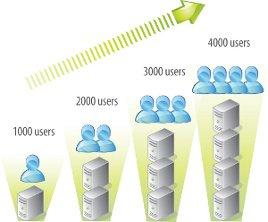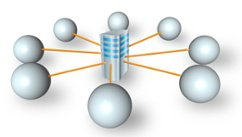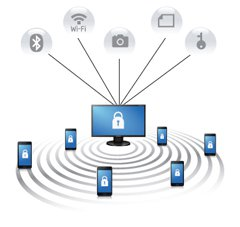Introduction to Mobile Communication
Mobile Communication is the use of technology that allows us to communicate with others in different locations without the use of any physical connection (wires or cables). Mobile communication makes our life easier, and it saves time and effort.
A mobile phone (also called mobile cellular network, cell phone or hand phone) is an example of mobile communication (wireless communication). It is an electric device used for full duplex two way radio telecommunication over a cellular network of base stations known as cell site.
Features of Mobile Communication
The following are the features of mobile communication:
- High capacity load balancing: Each wired or wireless infrastructure must incorporate high capacity load balancing.
High capacity load balancing means, when one access point is overloaded, the system will actively shift users from one access point to another depending on the capacity which is available.

- Scalability: The growth in popularity of new wireless devices continuously increasing day by day. The wireless networks have the ability to start small if necessary, but expand in terms of coverage and capacity as needed - without having to overhaul or build an entirely new network.

- Network management system: Now a day, wireless networks are much more complex and may consist of hundreds or even thousands of access points, firewalls, switches, managed power and various other components.
The wireless networks have a smarter way of managing the entire network from a centralized point.
 Role based access control: Role based access control (RBAC) allows you to assign roles based on what, who, where, when and how a user or device is trying to access your network.
Role based access control: Role based access control (RBAC) allows you to assign roles based on what, who, where, when and how a user or device is trying to access your network.
Once the end user or role of the devices is defined, access control policies or rules can be enforced.
- Indoor as well as outdoor coverage options: It is important that your wireless system has the capability of adding indoor coverage as well as outdoor coverage.
- Network access control: Network access control can also be called as mobile device registration. It is essential to have a secure registration.
Network access control (NAC) controls the role of the user and enforces policies. NAC can allow your users to register themselves to the network. It is a helpful feature that enhances the user experience.
- Mobile device management: Suppose, many mobile devices are accessing your wireless network; now think about the thousands of applications are running on those mobile devices.
How do you plan on managing all of these devices and their applications, especially as devices come and go from your business?
Mobile device management can provide control of how you will manage access to programs and applications. Even you can remotely wipe the device if it is lost or stolen.

- Roaming: You don't need to worry about dropped connections, slower speeds or any disruption in service as you move throughout your office or even from building to building wireless needs to be mobile first.
Roaming allows your end-users to successfully move from one access point to another without ever noticing a dip in a performance.
For example, allowing a student to check their mail as they walk from one class to the next.
- Redundancy: The level or amount of redundancy your wireless system requires depends on your specific environment and needs.
- For example: A hospital environment will need a higher level of redundancy than a coffee shop. However, at the end of the day, they both need to have a backup plan in place.
- Proper Security means using the right firewall: The backbone of the system is your network firewall. With the right firewall in place you will be able to:
- See and control both your applications and end users.
- Create the right balance between security and performance.
- Reduce the complexity with:
- Antivirus protection.
- Deep Packet Inspection (DPI)
- Application filtering
- Protect your network and end users against known and unknown threads including:
- Zero- day.
- Encrypted malware.
- Ransomware.
- Malicious botnets.
- Switching: Basically, a network switch is the traffic cop of your wireless network which making sure that everyone and every device gets to where they need to go.
Switching is an essential part of every fast, secure wireless network for several reasons:
- It helps the traffic on your network flow more efficiently.
- It minimizes unnecessary traffic.
- It creates a better user experience by ensuring your traffic is going to the right places.
Advantages of Mobile Communication
There are following advantages of mobile communication:
- Flexibility: Wireless communication enables the people to communicate with each other regardless of location. There is no need to be in an office or some telephone booth in order to pass and receive messages.
- Cost effectiveness: In wireless communication, there is no need of any physical infrastructure (Wires or cables) or maintenance practice. Hence, the cost is reduced.
- Speed: Improvements can also be seen in speed. The network connectivity or the accessibility was much improved in accuracy and speed.
- Accessibility: With the help of wireless technology easy accessibility to the remote areas is possible. For example, in rural areas, online education is now possible. Educators or students no longer need to travel to far-flung areas to teach their lessons.
- Constant connectivity: Constant connectivity ensures that people can respond to emergencies relatively quickly. For example, a wireless device like mobile can ensure you a constant connectivity though you move from place to place or while you travel, whereas a wired landline can't.
|




 For Videos Join Our Youtube Channel: Join Now
For Videos Join Our Youtube Channel: Join Now










